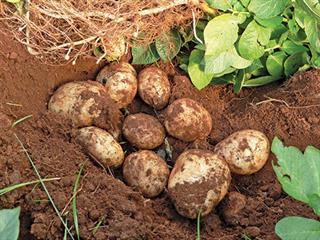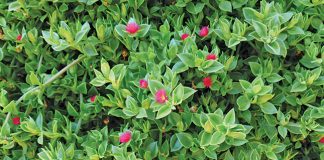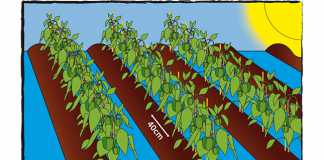
Use seed potatoes if you can’t find seedlings or potato seed from nurseries. A seed potato is any potato that has grown an “eye”. The eye is a young sprouting stem.
When you buy a bag of potatoes, some already have eyes and can be used as seed potatoes. You can also make your own seed potatoes. Plant seed potatoes whole or cut them into pieces, each piece with at least one eye. Seed potatoes with many eyes will produce many small potatoes. Seed potatoes with fewer eyes will produce fewer but larger potatoes.
To protect the seed potato pieces from diseases, allow the cuts to seal for at least a day before putting them in the ground.
Step 1
Work the soil deeply with a fork. Remove stones, break large clods and rake fine. Prepare furrows 15cm deep and 1m apart.
Step 2
If you use chemical fertiliser, apply one handful per 1m furrow length. If you use kraal manure, apply four to six handsful of manure per 1m² before starting soil preparation, and work evenly into the soil. Rake fine and prepare the furrows as mentioned above.
Step 3
Plant the seed potato tubers about 30cm apart in the furrows, and cover them with enough soil to form a small ridge on top of the row.
Step 4
Water regularly (at least twice a week) from the time you plant until the young shoot appears above the soil surface. This can be anything from one week to three weeks after planting.
Step 5
When shoots emerge, the potato plants grow quickly. Cover the base of the plant with soil when the plant is about 30cm tall (cover about 20cm) to ensure that any potatoes forming under the ground stay there. If a potato is exposed to sunlight, it turns green and becomes bitter and inedible. During this growing period, water the potatoes regularly so they don’t hollow out inside.
Step 6
Harvest the potatoes when the plants are completely dry. As soon as possible, get the harvested potatoes in a dark, dry and cool place. You can sell your surplus crop to your local market or community.
Pests to watch out for include early blight, potato tuber moth and nematodes. Consult your farm supply store for advice on how to fight these pests.
Sources: Agricultural Research Council (ARC) and The New Complete Book of Self Sufficiency by John Seymour.
For more information call the ARC-Vegetable and Ornamental Plant Institute on 012 841 9611 or fax 012 808 1127.













